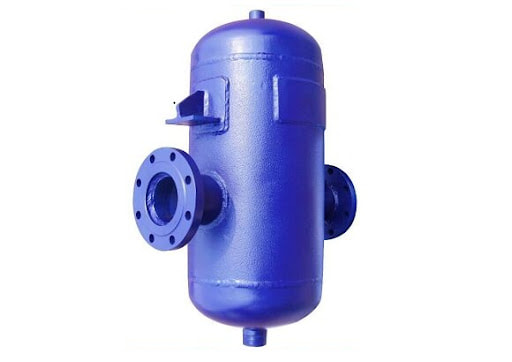Working Principle and Structure of Steam Water Separator
The working principle of the steam-water separator is to suddenly change the direction of steam or compressed air in the flow, separate the water droplets contained in the steam or compressed air, and reduce the water content in the steam or compressed air. The separated water droplets are collected under the separator and discharged through the additional drain valve. The steam-water separator can ensure the dryness of the steam or air used in steam-using equipment, improve the working efficiency of steam-using equipment, and extend the service life of the equipment.
The steam-water separator separates the liquid droplets in the gas, collects them at the bottom and discharges them from the liquid outlet, so that the dry gas is discharged from the outlet. The gas medium can be steam, compressed air, biogas, etc., so the steam-water separator is also called a vapor-liquid separator, steam dehydrator, air purifier, etc.

According to the structure classification, there are roughly four types:
1. Baffle type (baffle type).
2. Centrifugal type (cyclone type).
3. Centrifugal plate type.
4. Filter type (filter type)
The baffle-type steam-water separator removes the liquid medium in the medium through five stages of separation - speed reduction, centrifugation, collision, direction change, condensation and other processes to achieve purification. The baffle type is composed of many baffles. The fluid changes the flow direction many times in the separator. Since the suspended water droplets have large mass and inertia, when the flow direction of the baffle changes, the dry steam can bypass the baffle and continue. Moving forward, the water droplets will accumulate on the baffle. The steam-water separator has a large flow area, which reduces the kinetic energy of the water droplets. Most of them will condense, and finally fall to the bottom of the separator and be discharged through the drain valve.
The steam-water separator is also called a baffle-type steam-water separator. The baffle-type structure has many baffles, and the gas flows in multiple directions. The more small molecule droplets are separated, and the internal space is large and the flow rate is reduced, so that Small molecule droplets have enough time to condense into larger droplets without being carried away again by the gas to form secondary vapor. Due to the different specific gravity, large droplets will fall to the bottom and be discharged by the drain valve.
There are many ways to use baffle-type soda-water separators. The baffle-type soda-water separator is also called a labyrinth structure. The so-called baffle-type soda-water separator is generally considered to have the structure shown above. Compared with the baffle-type soda-water separator, due to the number of baffles There are fewer, and the arrangement is different. The gas only undergoes a single collision and deceleration, and only three or four changes of direction, so the separation effect will be worse.
The baffle-type steam-water separator can maintain a high separation efficiency in a large flow rate range. Research shows that the separation efficiency of the baffle-type separator can be close to 100% between the flow rate of 10m/s and 30m/s, and for For steam systems, the faster the flow rate, the greater the collision force, and the better the separation effect. It is not impossible to reach 100%. Multiple units can also be selected to be used in series according to the working conditions, and the separation efficiency can be close to 100%.



